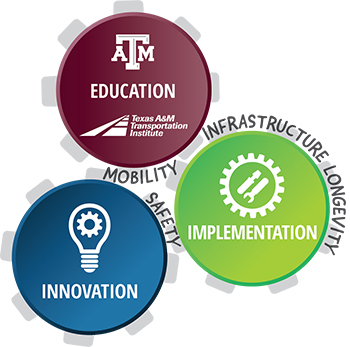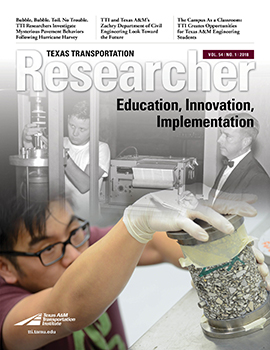
One of the most important assets we have in transportation research is intellectual capital. In the last century, the power of pioneering minds overcame seemingly insurmountable challenges to improve mobility, safety and infrastructure longevity.
Without that systematic application of innovative thinking, roads would have crumbled faster, more system users would have died or been injured, and more hours would have been spent sitting in traffic, undermining economic potential. While we’ll never have a perfect transportation system, we can always make it better with the thoughtful, practical application of innovative thinking.

This issue of the Texas Transportation Researcher examines the three pillars of successful transportation research: education, innovation and implementation. It’s through that continuum of technology transfer — from the classrooms of our academic institutions to the sponsored research projects testing new theories and methods to, finally, the implementation of those new discoveries — that we can facilitate improvements in our transportation network. Cut off any one of the three legs of the stool, and the whole thing topples over.
Founded in 1950 as a research support arm of the Texas Highway Department, the Texas A&M Transportation Institute (TTI) has always recognized the potential to both benefit and benefit from student researchers. We’ve worked closely with Texas A&M University’s Zachry Department of Civil Engineering (CE) for nearly 70 years, a relationship fostered by faculty with shared appointments in both organizations. It’s maybe a little cliché to describe education as an investment, but like most clichés, that description is based in fact. From traffic operations to safety to materials and structures research, our symbiotic relationship with CE and Texas A&M student researchers — from the classroom to the roadbed — has produced numerous innovations to benefit citizens not only in Texas and the nation, but around the world.
TTI shares similar partnerships with other Texas A&M entities, such as the College of Architecture and the Texas A&M Health Science Center School of Public Health. We’re currently teaming with the Bush School of Government and Public Service and Texas A&M’s Mechanical Engineering, Computer Science, and Industrial and Systems Engineering Departments, as well as the Texas A&M Engineering Experiment Station, on the Campus Transportation Technology Initiative to develop a smarter transportation ecosystem for the University’s main campus.
Our mission as part of Texas A&M’s land-grant charter is to enhance the education of Texas A&M’s students however we can. Marrying classroom instruction with applied research in the real world, TTI and its academic partners are providing a well-rounded educational experience to tomorrow’s transportation professionals. Through state-of-the-art research facilities at The Texas A&M University System’s RELLIS Campus, like the now-operational Center for Infrastructure Renewal, students will enjoy more advanced hands-on learning opportunities than ever before. And leveraging their intellectual capital will yield dividends for all of us as we work, together, toward a more connected, smarter and safer transportation network in the decades to come.
